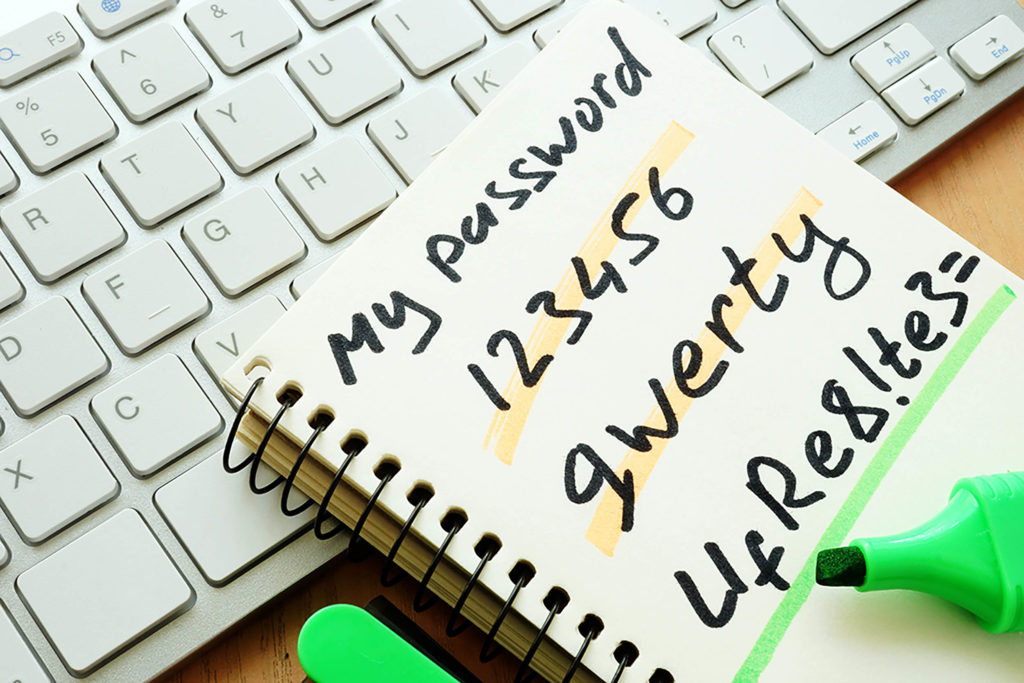Learn More About Password Security
Passwords are foundational in our internet-centric lives.
They’re also a source of stress and frustration for many of us. In this blog post, you can learn why complex passwords are important AND how to write them yourself! By learning more about password security you can take the first steps to keep yourself safe online.
When password protection was originally implemented, it was common practice to use an easy-to-remember password. When you first signed up for email the requirements around password creation were lax. It was easy to put the year you were born at the end of your dog’s name and move on. But as travel, news, and bank sites moved to online platforms, things got more complicated.
It’s commonplace now to have every website where we stream, shop, and socialize require password access.
Now, this happened for good reasons. There is valuable information about you available behind that log-in: your full name, credit card number, bank account number, and site history. It’s necessary for websites to level up their security regularly to protect you! It’s also important to know whether sites use plaintext or encryption to store your data.
But even the risk of data breaches hasn’t changed our password-picking patterns. Many folks still use their children’s or pet’s names when choosing a new password. Unfortunately, this information is easy to guess, or social engineer, for a competent fraudster.
Honestly, it doesn’t take much more than a simple computer program to bypass your Fido1970 or PearlJam1991 level of security.
But don’t get discouraged! Now is the perfect time to take ownership of your passwords and, in turn, your data.
Now, it’s not as simple as having three passwords, all equally complicated, that you rotate through. If one password is compromised for a shopping site, but you also use it for your credit card account, you’re vulnerable there too.
The best option for password security is to start using a third-party password manager. This is a service that can generate random secure passwords for you. You can even designate if you want these passwords to be easy to say or read. They also store those passwords in apps and browser extensions that are easy to use. Many can also be integrated into your browser so they auto-fill as you navigate through your online life.
Most browsers (Chrome, Safari, Firefox, Edge, etc.) make secure password suggestions that are then saved across your devices. The downside is that some websites require different password formats than the browser suggestions. Browser password management can work well if you use the same browser across all devices but can easily be compromised if your email password is stolen.
If you want to manage your own passwords, here are some tips on how to create the most secure passwords. Let’s walk through the process of building a password that’s easy to remember but difficult to crack.
Length
The number of characters used in your password has become one of the easiest ways to ensure you’ve got the upper hand against internet criminals. Some sites have requirements for minimum length but many don’t have limits for maximum length. Having short sentences that you can remember (thesnailsinmyyardarebrown) works better than a memorable word or name. Try thinking of inside jokes, fake information about yourself (also good for security questions).
Uppercase & Lowercase
Incorporating both uppercase and lowercase letters is a fairly common requirement for password creation across the internet. It’s easy to add an uppercase letter at the beginning of your new pass-sentence and move on but mixing it up can increase that security. Let’s take the example from above and make it more secure:
thesnailsinmyyardarebrown becomes tHesNailsInmYyarDareBroWn
Numbers
By adding length and case variance you can already see how this password is more secure than Fido1970. But the use of numbers is valuable and numbers can be added to any password. Check this out:
tHesNailsInmYyarDareBroWn can be tHe5Nai1sInmYyarDar3Br0Wn
This looks like nonsense, but it’s still memorable and readable. Creating a password that is annoying to explain means it’s a more secure choice. The less you share your password the better off you are.
Symbols
Now, symbols are crucial. But they’re also the easiest to tack on the end of a password and call it a day. This isn’t the best choice. Try something like this:
tHe5Nai1sInmYyarDar3Br0Wn is more secure as tHe5N@i1$InmYyarDar3Br0Wn!
Using symbols that look like letters can make these substitutions more intuitive and easier to remember.
Creating complex passwords to keep your data more secure doesn’t have to be a chore. It can be fun! But to reset passwords one after the other for account after account can still result in a daunting undertaking. Then you’re faced with where to store them. Yes, you can write them in a notebook that you keep in your home office. Or even create a stack of post-it notes that are an ever-evolving collection of outdated passwords. But accessibility is important too. Being able to copy and paste your new complex and hilarious passwords into Netflix from the airport is life-changing. A locked excel file stored in the cloud could work, but ultimately, password manager apps are the way to go. There’s a style of password storage for all types. But the first step is to stop reusing Fido1975 for all your logins.




